During the months leading up to the 2014 NBA Draft, we took a critical look at a few groups of draftees and explored some of their personality differences. Our first piece focused on the key differences between players labeled as Steals and Busts by NBA scouts. In this study, we boiled down the nuances of measurable personality traits into a series of easy-to-digest categories. These categories help to create a simple overview of the strengths and limitations that may help or hinder an athlete's success.
Our second study took a deeper look into the background history of a group of players based on their high school recruiting rankings. The purpose of this study is to take an initial look at a facet of a player's Individual Story and how it could potentially impact how they act and react to the various situations and opportunities that arise during the early stages of their development.
More From Eric Weiss
-Breaking Bad: The Thin Line Between Busts & Steals
-Opportunity Knocks: How Situation Impacts Success, Part I
In Part II of our Opportunity Knocks series we will start to explore in more detail the role that situation plays into an athlete's development. Basketball lends itself beautifully to Behavioral Psychology and Sociological research, thanks to the myriad of data resources so conveniently provided on everything an athlete does, and the situations he or she does them in. Sports in general are an ideal forum for exploring the nature versus nurture concept and how it impacts player development. But before we can begin we must use the available data to define the following:
-The core psychological principles to focus on using statistical and personality data
-The statistical data necessary to create measurable Situation Factors
-The personality data necessary to categorize players by Personality Type
Working in conjunction with DraftExpress, Sports Aptitude has spent the past two years creating a classification system designed to help quantify both personality and situation in order to more effectively research trends in player development. For the 2014/15 season, we will be tracking player development trends using this system to study the growth of the following 123 NBA players as they enter into Year's One through Three:
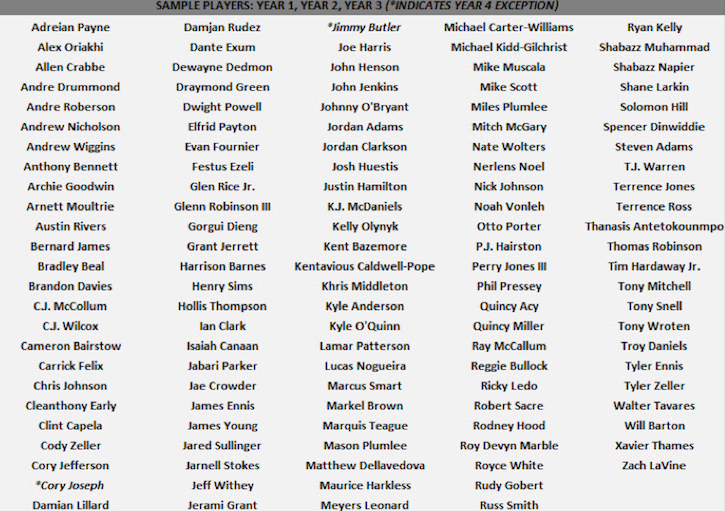
PART I: HOW SITUATION IMPACTS CORE PSYCHOLOGY
This sample group of players represents a mix of various First and Second Round draft picks, with a minimum of two players from every team in the NBA. There are four main Situation Factors and twelve total situation variables that we will be tracking throughout the season. Using a combination of player/team performance data and formulaic calculations allows us to control for a set of measurable situation-specific criteria that we can use to compare player development scenarios. This creates an apples to apples set of comparative tools with which to study the effects of situation and personality on player development.
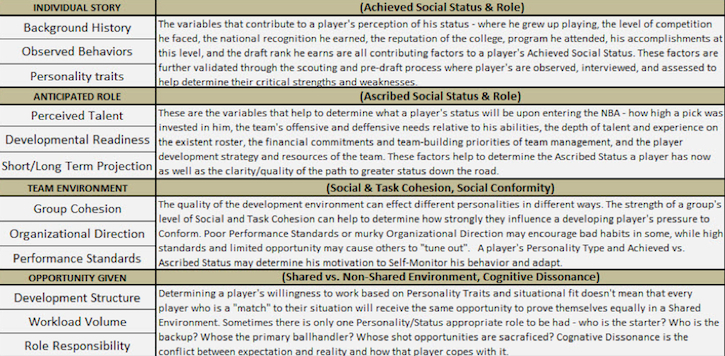
Understanding the opportunities and challenges these players will face this season requires a basic overview of a few key factors that are essential to behavioral research:
SOCIAL STATUS & ROLE: Achieved vs. Ascribed
Status and Role refer to the position one occupies within a group, the responsibilities required, and the prestige of the position itself. These are important for understanding behavior because they reflect a set of duties, obligations, and expectations relative to the position. Achieved Status is a position that one earns from merit. It reflects the skills and abilities of the individual and is a reflection of their past accomplishments. Ascribed Status is the position one is assigned to regardless of past history, being neither earned nor chosen by the individual.
Basketball Relevance: It doesn't matter if you were a McDonald's All-American coming out of High School. Nobody cares that you were the leading scorer for a National Championship team. Only you remember that time you dunked on LeBron James. You are now a Second Round pick who is buried on the depth chart behind a bunch of mid-level veterans who never accomplished half the things you did before coming into the league. Your team finished in the lottery five years in a row and you know that if you got a chance you could make a difference so what are you going to do about it? You can sulk, tune out, and tell yourself that your better than this or you can self-reflect and figure out what you need to do in order to get your shot to prove you're the best option.
GROUP COHESION: Social vs. Task
The cohesion of a group is a measure of its unity. This can be measured in two main ways: The strength of the interpersonal relationships within the group and the level of effectiveness the group has when executing tasks. Both of these facets are meant to measure the way a group comes together in pursuit of a common purpose. High group Social Cohesion reflects individuals who share common backgrounds, values, and personality traits, which help to promote attraction to one another. High group Task Cohesion reflects in the quality of a group's performance, which can create a greater sense of value for a new member to gain entry and acceptance. However, Social and Task cohesion can be mutually exclusive having one doesn't necessarily ensure having the other.
Basketball Relevance: Veteran teams typically win more in the NBA than teams filled with young developing players. Experience is extremely valuable for more than just developing individual skills. Veteran players typically have settled into their roles, earned their paychecks, and established their identity and value. Bringing together these types of players makes it easier to define roles and build a competitive team. However, personal agendas can erode a veteran core or corrupt a young player's priorities even when performance standards are high and organizational direction is clear.
Getting buy-in is much easier when players have things in common personally. Making sure those common interests are conducive to a winning culture can be more important for development than simply sticking a talented young kid into a group of established vets and expecting a magical transformation.
SOCIAL CONFORMITY: High Self-Monitor vs. Low Self-Monitor
Social Conformity is the general pressure on an individual to adjust their behavior to fit the expectations of those around them. As mentioned above, highly cohesive groups can increase the pressure to conform due to their performance status or their overall unity. Self-Monitoring is defined by the level that an individual attempts to adjust their behavior to in order to gain positive feedback. A High Self-Monitor is someone whose behavior is heavily influenced by the situation they are in. A Low Self-Monitor is someone whose behavior remains relatively consistent with their personality traits, regardless of situation.
Basketball Relevance: This is at the heart of understanding the value of your team drafting a project player who is developmentally raw, or taking a flyer on the low risk/high reward lottery bust that might benefit from a change of scenery. Having a winning culture isn't going to move the needle much for a player that is not motivated to meet the expectations of the group. On the other side of the equation, knowing more about a player's motivations can help determine whether a surprise jump in production is more about team chemistry or simply a contract year anomaly.
DEVELOPMENT ENVIRONMENTS: Shared vs. Non-Shared
Typically this concept refers to the influence of family on core personality. For our purposes we will treat the team as the family unit in order to understand how shared and non-shared environments impact behavior and effect development. Shared Environments are the things that two or more individuals share in common. Non-Shared Environments are the things that two or more individuals do not share. The region someone comes from, their socio-economic background, their age, position, work experience, job environment, and Achieved/Ascribed Status are all factors that can be Shared or Non-Shared.
Basketball Relevance: Two players enter the league with similar backgrounds and personality types. Both were high level recruits from the Southeast, both starred at elite college programs, played the same position, and both were one and done players who ended up on the same team as high lottery selections. But one player is projected to be the starter and have a central role in the team's offense, while the other is projected to have to fight for a spot in the rotation with a hungry Second Round pick that has turned some heads early in camp. How will each respond?
COGNITIVE RELATIONSHIPS: Consonant vs. Dissonant
Cognitive Relationships are defined by the consistency of an individual's beliefs/values/expectations relative to the actual situation they find themselves in. A Consonant relationship occurs when there is consistency between the individual's expectations and reality. A Dissonant relationship is when there is inconsistency between the individual's expectations and reality. People strive to reduce inconsistencies in order to limit stress and anxiety, which takes four different forms:
1. Changing behavior
2. Justifying behavior by changing conflicting thoughts
3. Justifying behavior by adding new expectations
4. Ignoring the information that conflicts with expectations.
Basketball Relevance: Lottery Pick X is fighting for a spot in the rotation with Second Rounder Y. The team just traded their star player and Lottery Pick X thinks he deserves to play because the team needs his offense in the lineup. The coach prefers Second Rounder Y because he knows all of the defensive rotations and sets a tone defensively for his teammates. The coach has told Lottery Pick X that he needs to work on his shot selection:
PLAYER X EXPECTATION: Coach should give me the job I can help this team.
PLAYER X BEHAVIOR: Pressing too much offensively and not focusing enough defensively.
Player X has the following choices:
1. I need to take better shots and tighten up my defense.
2. I'm the best offensive weapon on this team. I should be allowed a bad shot or two.
3. If I tighten up my defense and hustle, I can earn more freedom offensively.
4. It's the coach's fault. He doesn't know what I can do.
PART II: FINDING BEHAVIORAL BALANCE
In order to make sense of how situation is influencing player development, we need to define the personality types of the players we are studying. Most personality classification systems create a single category for each person to be assigned to. There are five main categories, which we call Personality Groups that lump players together by their general similarities. However, people are made up of both positive and negative qualities and it's these qualities that will either positively or negatively react to the situations they are placed in.
We've elected to categorize player personality using the concept of Behavioral Balance taken from our previous study of Steals and Busts. Each player matches to both a highly successful and highly unsuccessful sub-group of players from the five Personality Groups call this the Angel versus Devil on your shoulder. These players have significantly different personality traits than the norms of their Personality Groups. This allows us to categorize players by their best and worst qualities, instead of lumping the good and bad together. These personality types allow us to measure the strength of the match as well as the Behavioral Balance between the two, depending on which is stronger.
Here are the ten types, listed by their most common pairing:
YES MAN VS. WORRY WART
The Yes Man makes up for their lack of team mentality with an overabundance of fear and a healthy degree of flexibility. They don't challenge authority or seek control, choosing the path of least resistance to satisfy their needs. Their desire to maintain their independence and avoid scrutiny helps them to remain self-aware and to moderate their actions in order to fit in. They find success in situations where the organization knows what it's trying to build and understands how they fit into the puzzle. This allows them to keep their heads down and stick with the program as they observe and adjust to a more predictable developmental plan.
The Worry Wart's problem is that they allow their fear to limit their decision-making flexibility. Instead of trying to appease the powers that be to avoid conflict, the Worry Wart "digs in" and tries to control everything in a desperate effort to avoid what's uncomfortable or unfamiliar to them. Their high skepticism and inability to plan effectively creates an atmosphere where they spend more of their energy trying to figure out ways to get things back to the way they would like them instead of finding solutions to their problems based on the way things are. The Worry Wart is a self-fulfilling prophet, whose efforts to avoid risk often place them in the most danger.
UNIVERSAL SOLDIER VS. TERMINATOR
The Universal Soldier is a classic lead by example type. They set the standard for others to follow and can be pretty unforgiving to anyone who fails to live up to their responsibilities. However, they have enough empathy to understand that every soldier may need to be motivated differently. This allows them to adjust tactics to get the whole unit up to snuff. They're pretty reliant on outside instruction, best utilized when receiving orders from the general. They'll do better in situations that give them the high level of responsibility they are looking for within a group that has clearly defined roles for its members because they thrive off of order and certainty.
The Terminator's path to success is frequently short-circuited by their inability to internalize feedback and make adjustments. They fool themselves into believing that their strong work ethic and competitive drive make them perfectly honed killing machines, with no assembly required. In their mind, their way is absolute and all lesser beings are obsolete. When they find themselves in situations that present challenges, they expect to be given the necessary opportunity to prove themselves. When that opportunity doesn't come, they often convince themselves that change isn't necessary because they weren't given the chance to prove their righteousness in the first place.
RAINMAKER VS. TRUST FUND BABY
The Rainmaker gets what he wants by figuring out what other people want and then working his agenda into theirs. There is often trial and error in this process early on, as they learn how to hone their skills. This could explain why so many of them were late bloomers who were sometimes criticized for being BS artists earlier in their developmental process. The Rainmaker is definitely a manipulator of situations, but most often with a genuine interest in seeing all parties get what they want. They thrive best in situations where there is immediate opportunity to start working their way up the food chain.
Trust Fund Babies simply expect things to work out for them regardless of circumstance. Their track histories of success tend to reinforce their belief in themselves and they are often slow to react to warning signs. Because of this, they tend to overplay their hands and miscalculate the security of their position. Their belief that people should adjust to them, instead of the other way around, often makes them blind to both the opportunities and threats in front of them. Trust Fund Babies often lack the tact necessary to be master manipulators because their sense of entitlement causes errors when evaluating their leverage in situations. The less experience they have dealing with disappointment, the less aptitude they have for balancing their agenda against available opportunity.
FREE SPIRIT VS. WILD CHILD
The Free Spirit marches to his own drum, with an intense passion that drives him in everything he does. They are guided by their emotional reactions to situations, making their choices in the heat of the moment off of what they "feel" is the "right thing" to do at the time. They are independent-minded and impulsive, which can cause problems when they are put in the wrong situations. However, Free Spirits are fiercely loyal to those they grow close to and their decisions are heavily influenced by the relationships they form. The more time they spend with a close-knit group of teammates the more they will moderate their actions to meet the approval of those they call "friends.
The Wild Child is just plain difficult to control. This attitude is one of apathy to external rules and standards at the start as they tend to be "walled off" with a strong set of internal values and personal influences that aren't easily penetrated. "A tough nut to crack" is one way to describe the Wild Child. They aren't overly concerned about changing just to gain approval or acceptance. Their habits and priorities are hard-wired and their motivation to change may depend on how closely the tasks they're given align with their personal goals and values. If they burn bridges early in a situation where other options are available, it could be the final nail in the coffin.
IRRESISTABLE FORCE VS. IMMOVABLE OBJECT
The Irresistible Force is a practical-minded and highly goal-oriented thinker who tends to have strong beliefs. It may be difficult to convince them to change their viewpoints without a great deal of evidence, but they are light-hearted by nature and interested in finding common ground. Their steadfast nature and strong awareness of expectations makes them reliable under pressure and their tough-minded approach is softened by their commitment to "team. Irresistible Forces may not give ground easily, but they rely heavily on communication and group consensus. They believe in addressing issues head-on and prefer to discuss their viewpoints with others directly in order to understand all sides of an argument.
The Immovable Objects has supreme self-confidence in their beliefs, to the point where they may actively avoid situations that conflict with their existent beliefs. They are extremely goal-motivated and have no trouble taking chances in order to reach the objectives that they set for themselves. Immovable Objects have one-track minds and have difficulty seeing the perspective of others or the potential consequences of their actions because they don't take threats seriously. Instead of talking through their viewpoints to gain perspective, they often come into a situation with their minds already made up. It's not dominance that dooms the Immovable Object, but a lack of the self-awareness and humility necessary to see things as they are.
As we delve deeper into the personality type combinations, behavioral balance, and the situations they are asked to perform in, we should gain a better understanding how these factors influence an athlete's core psychology. As Bob Knight once said, Mental is to physical as four is to one.
PART III: PLAYER TRACKING THROUGHOUT THE YEAR
Appendix I through III below show the breakdowns of the sample group and their Behavioral Balance. The Percentile rank shows the strength of the player's match to his designated type, which represents how closely he matches the characteristics described in the section above. Draft Status is the quality of the draft pick invested in the player, which represents appreciating/depreciating value relative to both opportunity and production. Team Status is the quality of the host team's overall efficiency, which represents both the performance standards the player must live up to as well as the development structure he is exposed to in order to learn. All of these measures have been converted into five categories and color-coded highest, (1) to lowest, (5).
Draft/Team Status provides a very rudimentary look at the concepts of Individual Story/Perceived Talent and Team Environment/Opportunity Given. However, knowing the general quality of the individual relative to the quality of the team he is on helps to generate some interesting hypotheses when it comes to the player's personality types, their Behavioral Balance, and the situations they are placed in.
PERSONALITY AND SITUATION AT WORK:
Overall, there are only two Tier One/Two players who have a negative Behavioral Balance among the Year One sample group. The Free Spirit/Wild Child is only in the 46th percentile for his strongest Steal type match, indicating that he doesn't fit the mold perfectly for any of the five highly successful player sub-groups. However, he is in the 99th percentile for his Bust type match, indicating that he has strong similarities to the behavioral qualities of that group. So, how does this player avoid the pitfalls of his Behavioral Balance and maximize his chances at success?
Let's take a look at a hypothetical scenario for this player by analyzing the four situation factors at play:
1. Individual Story: 2.7 |Background History Tier 1|Observed Behaviors Tier 2|Personality Traits Tier 5|
What do we know about this player's background history relative to his measured personality traits based on observed behaviors? He has been an RSCI elite prospect since his early high school years, he attended an elite college program, and he performed at a near-elite level at that program by showing productivity and becoming a team leader. He is typically regarded as an emotionally invested, high-effort, hard-working player, but lacks elite on-court decision-making ability at times. He is generally regarded as being mature and coachable.
2. Anticipated Role: 2.0 |Perceived Talent Tier 2|Developmental Readiness Tier 2|Short/Long Term Tier 2|
What is the organization's perception of his talent and level of readiness to contribute in the short versus long-term team-building plans? The team has invested a high-level draft pick in him. The team's overall experience, efficiency, and success level is low, but there are a few quality veterans in place. He is expected to play a controlled, moderate role immediately with increased minutes and usage dependent on merit. Long-term he is projected to develop into a top six minutes earner or more, but there is no immediate pressure to rush his development.
3. Team Environment: 4.0 |Group Cohesion Tier 4|Organizational Direction Tier 4|Performance Standards Tier 4|
Has the organization fully committed to a cohesive group of players whose unity and performance standards create a strong influence to conform? The team has few long-term financial commitments to its rotation players. The overall productivity of its main rotation is fairly low and there are no clear cornerstone players. There are some solid assets, but most haven't reached a level that can impact the performance standards of the team enough to commit to.
4. Opportunity Given: 2.7 |Development Structure- Tier 3|Workload Volume- Tier 2|Role Responsibility- Tier 3|
Are there any strong positional examples to follow in the developmental structure of the team and is the workload and role responsibility more of an observer, active participant, or central figure? There are two high performance role models to emulate at his position. The lack of team depth and productivity still provides for a strong opportunity to get hands-on training. However, he will not be relied on to carry a heavy level of role responsibility as the team will keep things simple initially, until he masters his initial tasks.
Risk Assessment: Despite some strong Wild Child tendencies, this player has exhibited work habits and a maturity level that indicate his personal priorities align well with professional standards. The organization he is going to has shown a high level of commitment to his short and long term future. They will provide a solid level of opportunity for on the job training, allowing him to apply his high effort level as he explores what does and does not work on the NBA level. The strength of his personality lies in his critical thinking and creativity. While he may be hard-headed about arguing the righteousness of his viewpoints, he is a thinker and will attack challenges from a multitude of angles. The greater the challenges, the more he'll explore different ways of overcome them.
However, the overall team environment could be considered in flux and is unlikely to provide a heavy amount of pressure to conform for a player who appears to have low Self-Monitoring tendencies. There are some solid veteran influences, but the team is not reinforcing their influence with any open long term commitment. Therefore it may take longer for this player to break any bad habits as his high Achieved Status and prominent Ascribed Role may encourage him to continue doing the things that made him successful in the past. The longer he remains in a soft team environment with limited task cohesion the greater the likelihood he is to remain set in his ways, attempting to raise the bar in the absence of proven alternatives.
LOOKING AHEAD TO 2014/15 SEASON
Over the course of the season we will be taking a detailed look at each of the four Situation Factors by analyzing the impact of each factor on player performance for all 123 of the sample players. Each Situation Factor will reviewed Quarterly in twenty game segments in order to break up the analysis into four digestible parts, and to track developmental progress throughout the year. We will also be conducting structured player interviews throughout the season in order to get direct feedback from the athletes regarding their interpretation of their situational experiences.
The data we collect should provide the framework for one of the largest sociological research studies on professional athletes ever conducted. Our objective is to identify and improve our understanding of the critical situation factors that contribute to player development by increasing our knowledge of the nature/nurture influence on player behavior.
APPENDIX I: YEAR ONE PLAYERS
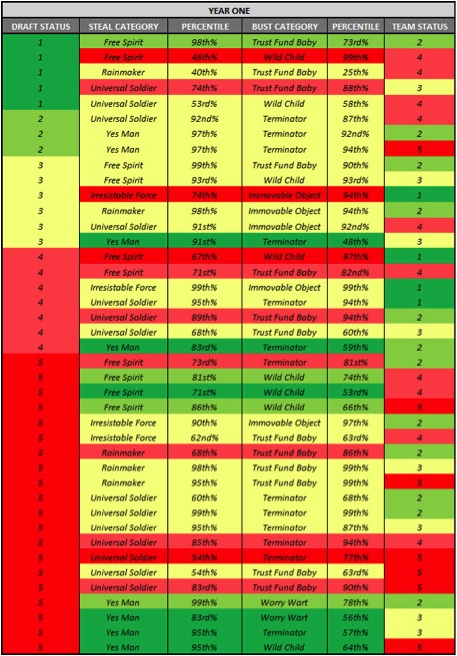
APPENDIX II: YEAR TWO PLAYERS
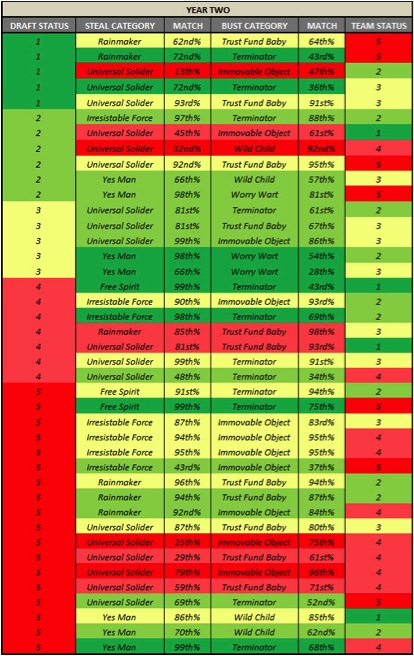
APPENDIX III: YEAR THREE PLAYERS
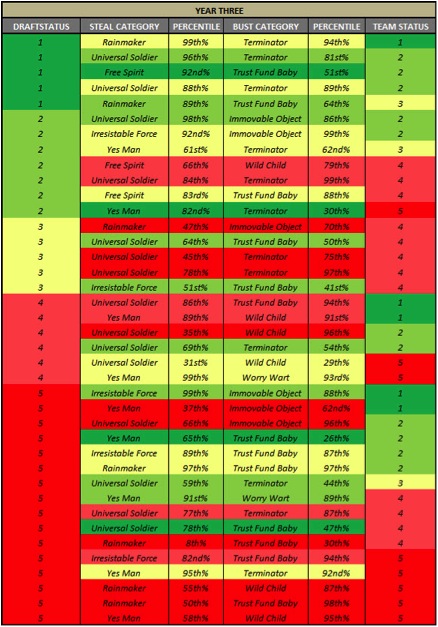













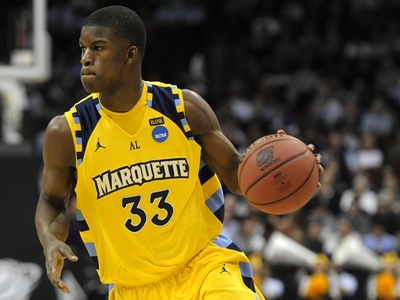











Comments